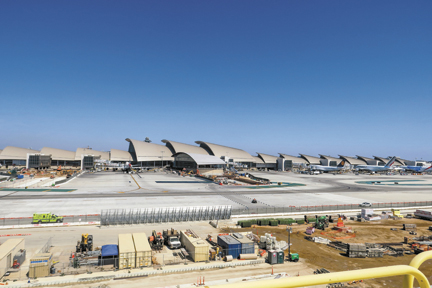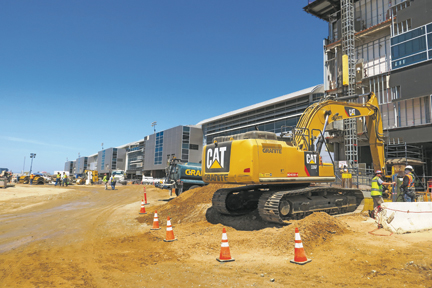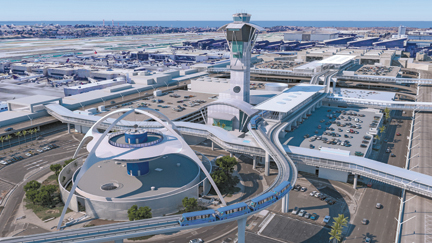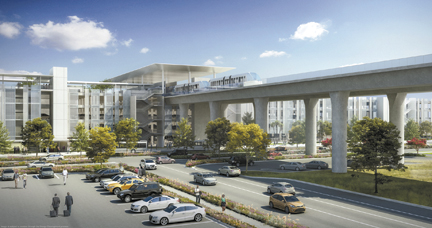Person A takes off from San Francisco for a 389-mile flight to Los Angeles International Airport's Terminal 4. At the same time, Person B exits the 405 freeway bound for the same destination just 2.5 miles away.

|

|
Construction is underway on a new midfield terminal connected to the international terminal (top) and the Automated People Mover (above) that will put hundreds of Local 11 members to work for the better part of a decade.
Photos courtesy Los Angeles World Airports
|
Who gets there first?
The answer, to the frustration of millions of Angelenos each year, is that those two trips can, and often do, take the same amount of time. The solution is expected to be the largest public works program in Los Angeles history.
"I have been there where it took an hour to go around the horseshoe," said Local 11 President Rusty Roten, referring to the airport's layout, which consists of nine terminals arranged around a looping central roadway. "There are so many cars, everyone is pulling over waiting, buses are everywhere. And then the person you're coming for doesn't come out and the curb cops move you along and its: 'Oh God, no.'"
The traffic is one of the reasons that LAX — the fourth busiest airport in the world — ranked 72nd in the annual Skytrax survey of customer satisfaction below Quito, Ecuador, and Delhi, India. Cars and shuttle buses circling the terminal ring are the only way 85 million passengers a year can get to or from their planes. Even in car-centric LA, that's unsustainable.
With the city set to host the Olympics in 2028, Los Angeles World Airport, LAX's owner and operator, has begun a nearly $14 billion rebuild. To use an LA metaphor, this is no mere botox here or a little nip there; this is a Kardashian-level reconstruction.
That is excellent news for the members of Los Angeles Local 11, who will see millions of man-hours of work over the next decade, said Business Manager Joel Barton.
"Typically, we look at a $1 billion project and think '10% is our work.' That hasn't been the case at LAX," Barton said. "With all the sensors, conveyors, surveillance, fire alarms … everything is electrical. It's not just lights, plugs and audio. It's very inclusive. We see 20 to 25% is going to be our work."
And it's often highly technical work with challenges that will test even the most seasoned electricians.
"Some of the locations are crazy busy or hard to service with equipment," said Roten, who was a business agent in the territory that includes the airport before he was elected to his new post. "The airport has helped us secure work with the airlines because they need work to be done right and they need minimal impact on airline operations. So, they say to the airlines, 'We will pay to have the union install it, and then you pay us back.'"
When complete, it will be the largest project in Local 11 history, employing hundreds of members for more than a decade.
"No doubt, 1,000 members will work there comfortably for quite a long time," Roten said. "A good portion of their careers will be spent here."
With the new collective bargaining agreement nailed down last year, the Rams-Chargers shared NFL stadium nearing completion, the NBA's Clippers looking for a new home and a planned convention center expansion attracting dozens of cranes for downtown hotels, Local 11 now has the largest apprenticeship class in its history. It will near 2,300 apprentices by the end of the year.
"These are good times to be a union electrician in Los Angeles," Barton said. "Our organizers are out there and getting aggressive."
Solving the Car Problem
The estimated $14 billion LAX budget covers more than a dozen individual projects across nearly every part of the airport, from how passengers get to the terminals to how planes take off and land. More than one-third of the funds are earmarked for the traffic-fixing Landside Access Modernization Program, and the largest single component — the $4 billion piece that ties it all together — is the Automated People Mover.
An elevated train — think rubber wheels instead of steel rails — will glide over the traffic snarls below, linking existing terminals to new rental car facilities, transportation facilities and more. Nearly 40% of the traffic on the core horseshoe is shuttle buses, according to LAWA. They will be exiled, unneeded as the driverless electric APM takes over.
The contractors are just completing geological studies to make sure the system will survive the occasional earthquake, Local 11 business representative Mike Costigan said. Once underway, Roten believes the APM will put several hundred Local 11 members to work, most visibly on the millions of multi-color LEDs that will pinstripe the side of the guideway.

|

|
Today, it can take 1 hour to get from the entrance of the airport to the terminals; after the two-dozen car rental lots are consolidated (above) and the APM is complete (top), that trip will take minutes.
Photos courtesy Los Angeles World Airports
|
Total travel time from one end to the other: 10 minutes.
LAX opened as Mines Field in 1928, but it wasn't until 1961 that Los Angeles Airport was truly a Jet Age destination. The airport was expanded and the iconic Theme Building, like a UFO hung from reinforced concrete arches, was set soaring above the largest airport parking lot in the world. And since everybody flying into LA needed a car to see LA, planners made a then-astonishing 1,000 "drive-yourself" cars available daily.
As the airport reinvented itself over the next 60 years, like the city it serves, it spread to fill every space available. Car rental companies fled the dense core and scattered to 20 lots around the airport.
LAMP will end the thousand little commutes and combine them into the colossal ConRAC, the Consolidated Rent-a-Car building. At 6 million square feet, not only will it be larger than all the terminals combined, it will be larger than the Mall of America and only 10% smaller than the Pentagon. Forget about 1,000 cars a day; ConRAC will have room for 20,000 cars, and it won't spill them onto a multitude of industrial surface streets but nearly straight onto the freeway.
But what about self-driving cars, asked the project planners. Won't a giant parking garage be pointless someday in the future when your car drops you off and heads home by itself? The garage is being built with flat floors, external ramps and ceilings high enough to hold HVAC so electricians of the future can transform the vestigial garage into a hotel or office if that future need arises.
The total cost for the ConRAC is nearly $2 billion.
One of the primary goals of LAMP is to end the tyranny of the shuttle bus and the private car. When complete, Angelenos will be able to do the unthinkable: skip the drive and take the Metro.
Future passengers will no longer brave the core. Arrivals to the airport will be consolidated just east of the horseshoe at two temples to transportation choice: the new Intermodal Transit Facilities, one near the ConRAC to the east mostly for cars, one to the west near the Metro Green Line and the future Metro Crenshaw/LAX Line. Both will serve as homes for regional and local bus lines.
Yes, Los Angeles has a rail transit system and, yes, Local 11 has the PLA for that work, too.
"You could be in Pasadena and get all the way to LAX on light rail," Roten said of the city nearly 30 miles by freeway from the airport. "It's incredible, really."
The total cost for both ITFs is below $1 billion.
Upgrading the Passenger Experience
No Hollywood relaunch would be complete without at least one completely new character, and for LAX it is the Midfield Satellite Concourse, a terminal floating out away from the existing Tom Bradley International Terminal. The MSC will handle the largest intercontinental long-haul planes, including the 555-seat double-decker A-380. Today, passengers deplane mid-airfield and are bused to terminals, a slow and unpopular process. With its wave-shaped roof and twin tunnels — one for people, one for luggage — the MSC's 12 gates will cost a cool $1.6 billion.
Alongside the LAMP project, the five major carriers and the many smaller airlines that call LAX home will reshuffle themselves around the horseshoe. By 2023, all nine terminals will have undergone nips and tucks at an average cost of $760 million each. Some companies, as with Delta's planned "SkyWay," are more ambitious: a nearly $1.9 billion project that will link Terminals 2 and 3 with the international terminal, bringing an end to inter-terminal shuttle bus transfers. But everyone from Southwest to United to American have something in store. A quarter billion dollars will be spent on escalators alone.
Behind the scenes, a billion more is being spent on automated luggage processing.
There are even rumors that a Terminal 10 will rise across Sepulveda Boulevard to the east, Roten said, and Southwest Airlines may double its footprint by building the so-called Terminal Zero where a parkin